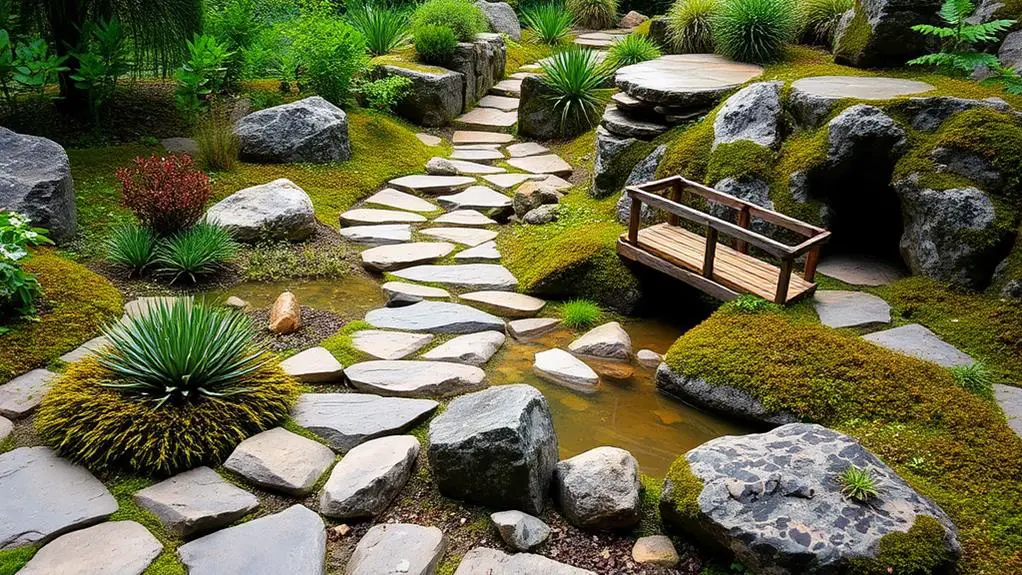As you explore ways to elevate your outdoor space, consider the understated charm of river rock gardens. By incorporating these natural elements, you'll create a visually striking contrast between the rocks and plants, adding texture and depth to your garden. River rocks can define pathways, create borders, and even build patios, but that's just the beginning. With the right design, they can also improve drainage and create a low-maintenance oasis. But what's the best way to get started? From border designs to patio ideas, there are countless ways to bring river rocks into your garden – and we're about to uncover them.
River Rock Border Designs

By incorporating river rocks into your border design, you can create a visually appealing and low-maintenance edge that defines your garden beds and adds texture to your outdoor space.
With river rock curves, you can soften the shift between your garden beds and lawn, creating a natural, effortless look.
To add visual interest, experiment with rock pattern variations, such as alternating large and small rocks or creating a spiral design.
Consider using rocks of different colors or textures to add depth and dimension to your border.
When selecting rocks, choose ones that complement your garden's style and color scheme.
For a modern look, use uniform rocks in a consistent color palette.
For a more rustic feel, opt for rocks with varied shapes and sizes.
Creating a Rock Garden Path
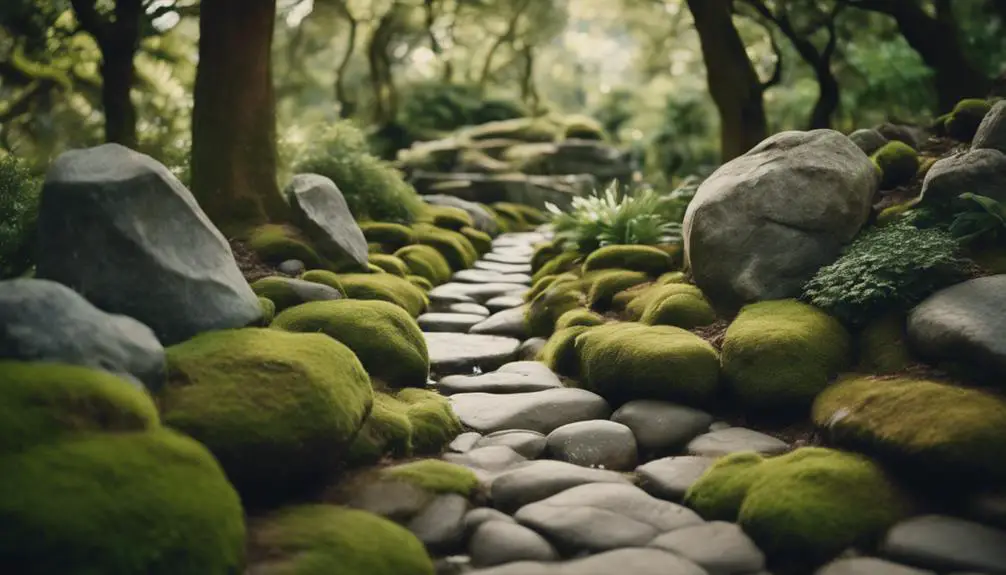
As you start designing your rock garden path, you'll need to ponder the type of rocks that will complement your garden's aesthetic.
You'll also want to decide on a pathway design that guides visitors through your garden, and finally, you'll need to figure out how to place the rocks and other materials in a way that creates a visually appealing and functional path.
Rock Selection Criteria
When designing a rock garden path, you'll want to select rocks that vary in size, texture, and color to create visual interest and depth. This diverse selection will add complexity to your design and create a dynamic visual experience.
Ponder rocks with different textures, such as smooth river rocks, rough granite, or weathered fieldstones. Mixing rock textures will add tactility to your path, inviting visitors to explore and engage with the space.
Rock hardness is another pivotal factor to ponder. Softer rocks like sandstone or shale may erode over time, while harder rocks like granite or basalt will withstand the elements.
Balance durability with aesthetic appeal by combining soft and hard rocks to create a visually striking path.
As you select rocks, think about the overall mood you want to create. Do you want a serene, natural atmosphere or a bold, modern statement?
Choose rocks that fit your vision, and don't be afraid to experiment with different combinations.
Pathway Design Options
To craft an enthralling rock garden path, you'll need to deliberate on the pathway's shape, width, and flow, as these elements will substantially influence the overall aesthetic and functionality of your design.
A meandering path, for instance, can create a sense of adventure, while a straight one can evoke a sense of simplicity.
When deciding on the width, consider the purpose of your path – will it be a strollway or a functional walkway?
River rock patterns can add visual interest to your pathway, so think about incorporating different sizes, colors, and textures to create a unique design.
To further enhance your pathway's ambiance, consider pathway lighting.
Strategically placed solar-powered lights or lanterns can highlight specific features, create dramatic shadows, or simply guide visitors through the garden.
As you design your pathway, remember to balance functionality with aesthetics.
Material Placement Tips
With your pathway design established, you're ready to start placing materials, carefully selecting and arranging river rocks to bring your vision to life.
Begin by creating a solid base layer of compacted gravel, ensuring adequate gravel density to support foot traffic and prevent settling.
Next, lay out your rock patterns, considering the size, shape, and color of each stone to create visual interest and harmony.
Start with larger rocks, placing them strategically to define the path's edges and create a sense of flow.
Fill in gaps with smaller rocks and pebbles, taking care not to overcrowd the area.
As you work, step back frequently to assess the layout, making adjustments as needed to achieve a natural, organic look.
Remember to leave space between rocks for plant growth and to create a sense of depth.
River Rock Patio Ideas
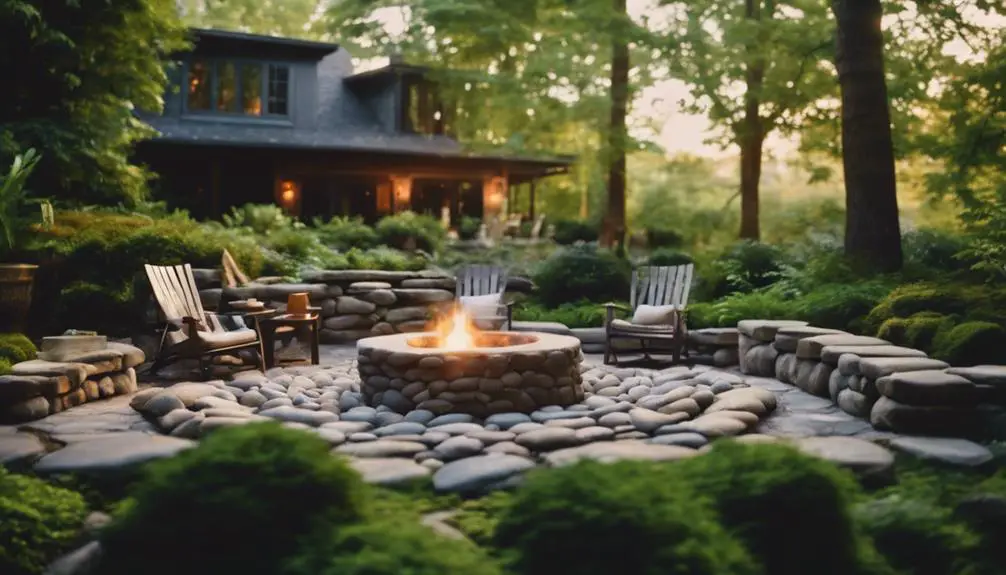
As you design your river rock patio, you'll want to ponder the overall aesthetic you're aiming for.
Will you create a rocky pathway that leads to a cozy seating area or define the patio's borders with a decorative river rock edging?
Rocky Pathway Designs
By incorporating river rocks into your pathway design, you can create a visually striking and rustic element that guides visitors through your outdoor space.
River rocks come in a variety of textures, from smooth and polished to rough and weathered, allowing you to choose the perfect fit for your design aesthetic.
To add visual interest, consider incorporating curved routes that meander through your garden or yard.
This design element not only creates a sense of flow but also encourages visitors to slow down and appreciate their surroundings.
When designing your rocky pathway, consider the size and shape of the rocks you're using.
Larger rocks can create a more dramatic effect, while smaller rocks can be used to create a more subtle, natural look.
You can also use a combination of rock sizes to create a visually appealing contrast.
Additionally, think about the color palette you want to achieve.
River rocks come in a range of colors, from neutral tones to bold, vibrant hues.
Patio Border Ideas
Defining the patio's perimeter with a river rock border adds a touch of sophistication and texture to your outdoor space, creating a clear distinction between the seating area and the surrounding landscape.
As you design your patio border, ponder the materials that will complement your river rock selection. You can combine river rocks with other border materials, such as brick, stone, or concrete, to create a unique and visually appealing patio boundary.
When selecting border materials, think about the overall aesthetic you want to achieve. Do you prefer a rustic, natural look or a more modern, sleek design? Ponder the color and texture of the river rocks and choose materials that will complement them.
You can also add plants or flowers along the border to soften the look and create a more inviting atmosphere.
Remember to ponder the functionality of your patio border as well. Will it need to contain mulch or soil? Will it need to withstand heavy foot traffic?
River Rock Accents
You can elevate your patio design by incorporating river rock accents, which add visual interest and create a sense of depth and dimensionality to your outdoor space. River rock accents can be used to create unique patterns, such as a meandering river effect or a geometric design, that draw the eye and add visual appeal to your patio.
To take your river rock accents to the next level, consider incorporating accent lighting effects. Strategically placed lights can highlight the texture and color of the river rocks, creating a dramatic and inviting ambiance in the evening. You can also use lights to create a sense of movement, by placing them along the path of a winding river rock pattern.
When selecting river rocks for your accents, choose rocks with varying sizes, shapes, and colors to create a visually interesting display. Consider using a mix of smooth and rough rocks to add texture and depth to your design. By incorporating river rock accents and accent lighting effects, you can create a patio design that's both beautiful and functional.
Incorporating Plants and Flowers

As you design your river rock garden, carefully select plants and flowers that thrive in well-draining soil and full sun to create a vibrant, low-maintenance oasis.
Consider using drought-tolerant plants like succulents, yarrow, and coneflowers that will complement the natural beauty of the river rocks.
When planning your flower arrangements, group plants with similar watering and sunlight requirements together to guarantee ideal growth.
For a visually appealing display, create a focal point with a statement piece, like a large succulent or ornamental grass, and then balance it with smaller, complementary plants.
When it comes to plant placement, think about the mature size of each plant and leave enough space for growth.
Consider the texture, color, and shape of the plants to create a harmonious contrast with the river rocks.
For example, pair smooth-leaved plants like hostas with the rough, textured surface of the rocks.
Rock and Mulch Combination
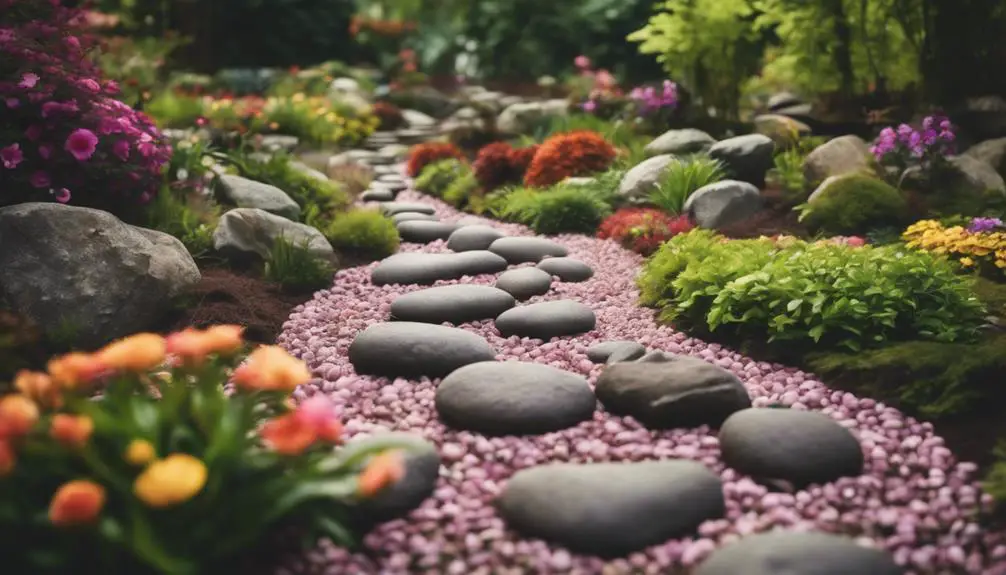
As you design your river rock garden, you'll want to carefully consider the rock and mulch combination to achieve the perfect balance of texture, color, and functionality.
You'll need to think about the rock color combinations that will complement your plants and flowers, as well as the type of mulch that will best retain moisture and suppress weeds.
Rock Color Combinations
Selecting harmonious rock color combinations with complementary mulch hues can elevate your river rock garden's aesthetic appeal, creating a visually striking contrast that draws the eye.
To achieve rock harmony, you can combine rocks with similar undertones, such as warm beige and golden brown, or cool gray and blue-gray. This creates a cohesive look that ties the entire garden together.
On the other hand, you can also use color contrast to add visual interest. For example, pairing dark gray rocks with bright orange or yellow mulch creates a bold, eye-catching combination.
Another option is to use a neutral mulch color, like brown or beige, and let the unique colors of the rocks take center stage.
Mulch Type Options
You can choose from a variety of mulch types to pair with your river rocks, each offering distinct benefits and textures that influence the overall look and feel of your garden.
Organic mulches, like wood chips or bark, provide a natural, earthy aesthetic and help regulate soil temperature. They also break down over time, adding nutrients to the soil.
Inorganic mulches, such as rubber or plastic, offer a more modern look and are low-maintenance, but may not provide the same mulch benefits as organic options.
When selecting a mulch, consider the level of mulch maintenance you're willing to commit to. Some mulches, like pine straw, need to be replenished regularly, while others, like gravel, require minimal upkeep.
Additionally, think about the color and texture of your river rocks and how they'll complement or contrast with the mulch. For example, a dark-colored mulch can make light-colored rocks pop, while a similar-colored mulch can create a cohesive look.
Layering Techniques
By combining river rocks and mulch in a thoughtful layering strategy, you can create a visually appealing and functional garden that showcases the unique textures and colors of each material.
To achieve a harmonious balance, start by applying a 2-3 inch layer of river rocks, varying the rock depth to create a natural, undulating effect. This will also help with drainage and prevent mulch from washing away.
Next, add a 1-2 inch layer of mulch, choosing a type that complements the color and texture of the rocks. Consider a dark-colored mulch to create a striking visual hierarchy, drawing the eye to the rocks' subtle hues.
Be mindful of the mulch's moisture content, as excess wetness can lead to mold and erosion.
DIY River Rock Water Feature

With a few simple materials and some creative planning, a DIY river rock water feature can become a tranquil oasis in your backyard, providing a soothing soundscape and visual appeal.
To create a unique fountain design, start by selecting a shallow container or basin that complements your outdoor space. You'll also need a pump, tubing, and a water reservoir to circulate the water.
Next, arrange the river rocks around the container, creating a natural-looking landscape. Add a few larger rocks or boulders to create visual interest and provide a sense of depth.
As the water flows through the rocks, it'll create a calming water sound that'll transport you to a serene atmosphere. To amplify the sound, consider adding a small waterfall or spout that flows into the container.
With some creativity and experimentation, you can design a one-of-a-kind water feature that harmonizes with your outdoor space. By incorporating river rocks into your fountain design, you'll create a visually striking and peaceful retreat that's perfect for relaxation.
River Rock Edging Ideas

River rocks, when strategically placed along the edges of your garden beds, pathways, or lawns, can create a visually appealing border that adds texture, color, and depth to your outdoor space.
You can experiment with different River Rock Patterns to create a unique look that complements your garden's style. For instance, you can create a random pattern by scattering rocks of varying sizes and colors along the edge, or opt for a more structured approach by creating a repeating pattern of large and small rocks.
When it comes to Rock Edge Styles, the possibilities are endless.
You can create a clean and modern look by using a single type of rock, or add some whimsy with a mix of colors and textures.
Consider using a combination of large rocks and smaller pebbles to create a dynamic, layered look.
You can also add some visual interest by incorporating other elements, such as plants or decorative accents, along the edge.
Whatever style you choose, river rocks are a versatile and low-maintenance option that can add a touch of elegance to your outdoor space.
Small Space River Rock Gardens

Even in compact spaces, you can craft a stunning river rock garden that showcases the beauty of these natural stones.
By strategically selecting plants and hardscapes, you can create an urban oasis in even the smallest of areas.
For small space river rock gardens, consider using a mix of small to medium-sized rocks in varying colors and textures to add visual interest.
To maximize space, use vertical elements like trellises or wall-mounted planters to draw the eye upward.
Incorporate low-maintenance plants like thyme or creeping sedum that can thrive in tight spaces.
Don't be afraid to get creative with your rock placement – try creating a small rock 'river' or using rocks to form a border around a tiny seating area.
With a little planning and imagination, you can turn even the most compact space into a serene and inviting retreat.
River Rock and Succulent Combo
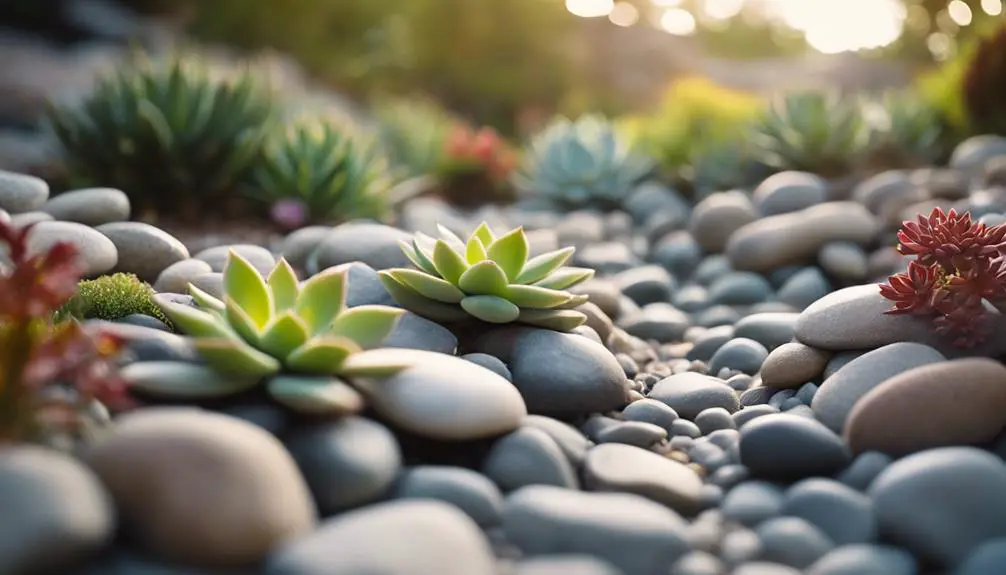
Combine river rocks with succulents to create a striking, low-maintenance garden that's perfect for busy homeowners who want to add some elegance to their outdoor space.
By pairing these two elements, you'll create a visually appealing contrast between the smooth, rounded river rocks and the unique textures of succulent varieties like aloe, echeveria, or crassula.
To add depth and interest, choose river rocks with varying rock textures, such as smooth, weathered rocks or those with a more rugged, rough-hewn appearance. This contrast will draw the eye and create a sense of movement in the garden.
When selecting succulents, consider their growth habits and sizes to guarantee a balanced arrangement. Group smaller succulents together or use a single statement piece as a focal point.
Remember to choose succulents that thrive in your local climate and require minimal watering and care. With a river rock and succulent combo, you'll enjoy a beautiful, low-fuss garden that's perfect for busy lifestyles.
Using River Rocks for Drainage
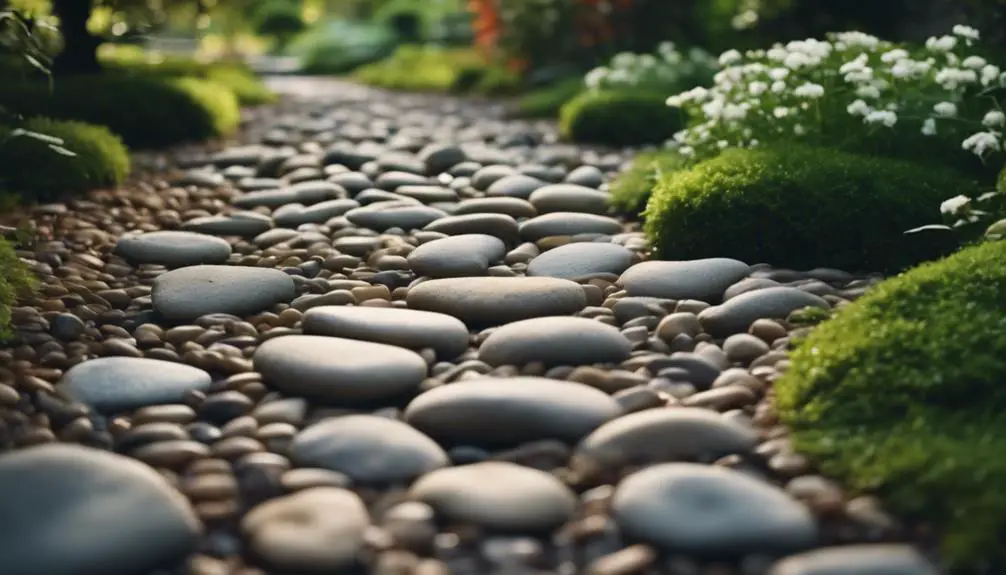
You'll also want to ponder using river rocks to improve your garden's drainage, a function that's especially important in areas with heavy rainfall or clay-based soils.
By incorporating river rocks into your drainage system, you'll create a more efficient way to direct water away from your plants and prevent waterlogged soil.
This is particularly vital for rainwater harvesting, as excess water can be collected and reused for irrigation.
River rocks can be used to create a French drain, a simple yet effective drainage solution that involves digging a trench and filling it with rocks and gravel.
As rainwater flows through the trench, it's filtered and redirected, reducing the risk of erosion and water damage.
By incorporating river rocks into your drainage system, you'll not only improve water flow but also reduce the risk of waterborne diseases and pests.
With a well-designed drainage system, you can rest assured that your garden will thrive, even in the most challenging weather conditions.
River Rock Stepping Stone Path

By strategically placing river rocks as stepping stones throughout your garden, you create a visually appealing and functional pathway that allows visitors to meander through your outdoor space while minimizing soil compaction and erosion.
This thoughtful design element not only enhances the aesthetic appeal of your garden but also serves as a practical solution for traversing your outdoor space.
To add an extra layer of creativity to your river rock stepping stone path, consider incorporating river rock art into your design.
You can arrange the rocks in intricate patterns, such as a meandering spiral or a geometric mosaic, to create a unique and eye-catching feature.
Alternatively, you can use different sizes and colors of river rocks to create a dynamic, multi-tonal effect.
Stepping stone patterns can also be used to add visual interest to your path, such as a staggered pattern or a radial design.
River Rock Accent Walls
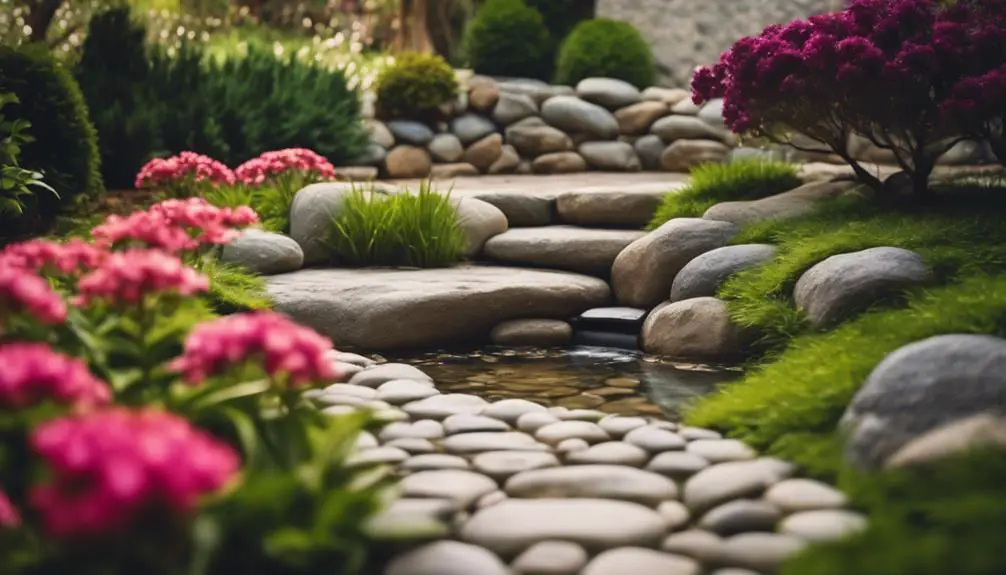
Incorporating river rock accent walls into your garden design creates a striking visual contrast that adds depth, texture, and dimensionality to your outdoor space.
By combining the natural beauty of river rocks with strategic lighting, you'll create an eye-catching feature that draws attention to specific areas of your garden.
The unique river rock texture adds an organic, earthy feel to your design, while the accent wall lighting highlights the rocks' natural hues and creates a dramatic ambiance in the evening.
To maximize the impact of your river rock accent wall, consider placing it near a seating area or water feature to create a sense of cohesion.
You can also use the wall to separate different zones within your garden, such as a vegetable garden from a relaxation area.
When choosing the type of river rocks to use, select ones with varying sizes and colors to add visual interest.
Don't forget to incorporate accent wall lighting to highlight the rocks' textures and colors, and to create a warm, inviting glow in the evening.
With careful planning and execution, your river rock accent wall will become a stunning focal point in your garden.
River Rock Mosaic Designs

As you venture into the world of river rock mosaic designs, carefully selected rocks in varying shapes, sizes, and colors come together to form intricate patterns, creating a visually stunning and unique addition to your garden.
With mosaic artistry, you can craft river rock patterns that tell a story, evoke emotions, or simply add a touch of elegance to your outdoor space.
To create a striking design, start by selecting rocks with varying textures and hues. You can choose a dominant color scheme or mix and match different colors to create a dynamic effect.
Consider using smaller rocks for intricate details and larger rocks for bold statements. Once you have your rocks, arrange them in a pattern that resonates with your personal style.
You can create geometric shapes, floral patterns, or even a mosaic representation of your favorite animal. With patience and creativity, your river rock mosaic design will become a showstopping feature in your garden, adding depth, texture, and visual interest to your outdoor oasis.
Frequently Asked Questions
How Often Should I Clean My River Rock Garden to Prevent Weed Growth?
To prevent weeds, you'll want to clean your garden regularly, ideally every 2-3 weeks, depending on climate and growth. Implement a rock maintenance schedule, incorporating weed prevention methods like mulching, boiling water, and targeted herbicides to keep your space tidy and thriving.
Can I Use River Rocks of Different Sizes and Colors Together Effectively?
When combining rocks of varying sizes and colors, you'll achieve rock harmony by balancing color contrast. Mix large, dark rocks with smaller, lighter ones to create visual interest, and use a unifying hue to tie the look together.
Are River Rocks Suitable for Gardens With Heavy Foot Traffic Areas?
You'll find that river rocks can withstand heavy foot traffic areas, but you'll need to contemplate traffic patterns to prevent soil erosion and compactation, ensuring a stable base that won't shift underfoot.
Can I Use River Rocks in a Garden With a Steep Slope or Hill?
When tackling a steep slope or hill in your garden, you'll need to prioritize slope stabilization and erosion control. By incorporating river rocks, you'll create a stable, visually appealing solution that prevents erosion and guarantees a safe, accessible space.
Will River Rocks Change Color or Fade Over Time When Exposed Outdoors?
You'll be pleased to know that high-quality river rocks boast excellent weather resistance, ensuring their vibrant hues remain intact. Colorfastness is key; look for rocks with durable pigments to prevent fading, and enjoy your outdoor oasis for years to come.
Conclusion
You've now got a solid foundation for crafting a stunning river rock garden.
By incorporating these design ideas, you'll create a visually striking outdoor space that's both low-maintenance and functional.
Remember to balance rock and plant textures, utilize river rocks for drainage, and don't be afraid to get creative with unique accent walls and mosaic designs.
With these tips, you'll be well on your way to building a serene and natural oasis that showcases the beauty of river rocks.



